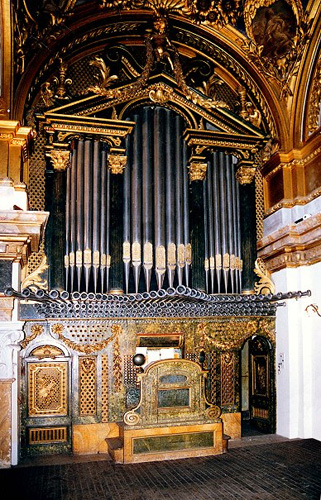


Madrid, Palacio Real

Leonardo Fernández Dávila and Jorge Bosch 1771-80
State of preservation: Restored in 1993 by Gerhard Grenzing.
In 1755 King Fernando VI had an organ planned for the new Royal palace in Madrid, and Leonardo Fernández Dávila negotiated with the architect J. B. Sacchetti about the proper position of the instrument, Because of the slow progress Dávila, advised by Antonio Soler, started building the instrument only in 1771 but due to illness could not finish the organ. So he recommended his pupil Jorge Bosch who had to complete several other orders and could finish the organ only in 1780.
A peculiarity of this fairly big instrument of 42 stops are the two swells, the upper division as well as the positive organ being completely enclosed and without a visible façade but moving doors for dynamic effects. To keep the action as simple as possible the main organ is played from manual III, the top division behind from manual II and the posititve from manual I.
Specification
III+P
bass | treble | |||
number | ||||
manual III C-c1 | c#1-d3 | |||
Flautado de 26 | 16' | 1 | Flautade de 26 | 16’ |
Violon de 26 | 16' | 2 | Violon de 26 | 16’ |
Flautado de13 | 8’ | 3 | Flautado de 13 | 8’ |
Violon | 8’ | 4 | Violon | 8’ |
5 | Flauta dulce | 8’ (2f., wood) | ||
Octava | 4’ | 6 | Octava | 4’ |
Tapadillo | 4’ | 7 | Tapadillo | 4' |
Docena y Quincena | 2 2/3’ + 2’ | 8 | Docena y Quincena | 2 2/3’ + 2’ |
Lleno | 5f. | 9 | Lleno | 5f. |
Nazardos | 4f. | 10 | Corneta | 6f. |
Cornett Tolosana | 3f. | 11 | Corneta Tolosana | 3f. |
12 | Trompete de 52 | 32’ | ||
Trompeta real | 8’ | 13 | Trompeta real | 8' |
Orlos de 26 | 16’ | 14 | Orlos de 26 | 16’ |
Fagot | 16’ | 15 | Obue | 8’ |
exterior reed stops | ||||
16 | Trompeta magna | 16’ | ||
Clarin bajo | 8’ (from F) | 17 | Clarin | 8’ |
18 | Clarin | 8’ | ||
Chirimia | 4’ | 19 | Chirimia alta | 4’ |
Violeta | 2’ | 20 | ||
Orlos | 8’ | 21 | Orlos | 8’ |
Viejos | 8’ | 22 | Viejas | 8’ |
manual II C-c1 | c#1-d3 | |||
Flautado de 13 | 8’ | 23 | Flautado de 13 | 8’ |
Flautado Violon | 8’ | 24 | Flautado Violon | 8’ |
25 | Flauta traversa | (2f., wood) | ||
Tapadillo | 4’ | 26 | Tapadillo | 4' |
Nazardos | 3f. | 27 | Corneta |
6f. |
Lleno | 3f. | 28 | Lleno | 3f. |
Zimbala | 3f. | 29 | Zimbala | 3f. |
30 | Trompeta magna | 16’ | ||
Trompeta real | 8’ | 31 | Trompeta real | 8’ |
Bajoncillo | 4’ | 32 | Clarin | 8’ |
33 | Chirimia alta | 4’ | ||
Voz humana en Ecos | 8’ | 34 | Voz humana en Ecos | 8’ |
manual I C-c1 | c#1-d3 | |||
Violon | 8’ | 35 | Violon | 8’ |
Tapadillo | 4’ | 36 | Tapadillo | 4' |
Quincena | 2’ | 37 | Quincena | 2’ |
Nazardos | 3f. | 38 | Corneta | 3f. |
39 | Octava de Corneta | |||
Lleno | 3f. | 40 | Lleno | 3f. |
Trompeta real | 8’ | 41 | Trompeta real | 8’ |
42 | Tiroba en Ecos | 16’ | ||
Voz humana a la Francesa | 8’ | 43 | Voz humana a la Francesa | 8’ |
pedal | ||||
12 keys of open 16’, combined with stopped Fifth 10 2/3’; 2 keys for Tambor and Timbal | ||||
Q: www.grenzinger.com Gerhard Grenzing, Jordi Bosch – der unbekannte Meister, in: ISO Yearbook 1993, S. 114-143.
© Greifenberger Institut für Musikinstrumentenkunde | info@greifenberger-institut.de



